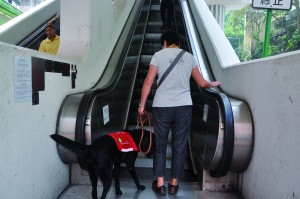Hong Kong last saw guide dogs on the streets in 1970s now they are back with a new generation of puppies in training
By Cherry Wong
On a sunny day, a labrador retriever leads its handler through the crowds while the handler follows, holding onto the handle that is attached to a snugly fitted harness on the dog. On their short journey from the handler’s home in Wong Tai Sin to the MTR station, many pedestrians stop to look and whip out their cell phones to take photos. The dog’s name is Rally and she is not an ordinary pet dog, she is a guide dog.
Rally’s everyday work is to lead her owner, Trada Yip Man-yee through her daily routine. Yip became blind around 10 years ago after developing glaucoma. She used to rely on a white cane to help her get around. However, the cane is only useful as a mobility tool up to a maximum height or distance of 2 ft below waist level. Whenever she went out, Yip had to be extremely cautious, or else she would end up bumping into passers-by or other obstacles.
The elderly people living in her building used to shout at her to warn her against accidentally hitting them with the cane. But around six months ago Rally came and brightened her life.

It took 26 days for Yip to master communication with Rally. Handlers communicate with their dogs through a variety of signals using voice, body gestures, and collar gestures. Now, with Rally’s assistance, Yip can walk much faster and further than before. “I’ve become happier, as all my neighbours like Rally a lot. After these six months, Rally gives me the confidence to get around,” Yip grins.
Yip finds she is now welcomed by strangers as people are often curious about Rally. She attracts attention and her presence starts conversations.
The history of guide dogs in Hong Kong can be traced back to 1975 when a German Hong Kong resident sponsored two guide dogs which received training in Australia to the territory. Unfortunately, due to a lack of local support and experience in handling guide dogs, one eventually died of disease and the other was killed in a car accident.
The guide dog service in Hong Kong was subsequently suspended as Hong Kong was not ready to produce guide dogs locally. Puppies chosen to be trained as guide dogs must have descended from at least seven generations of selectively bred guide dogs.
Guide dogs made a return to Hong Kong two years ago after two guide dogs were imported from Taiwan. At present, there are six guide dogs serving in Hong Kong and another six are receiving training provided by two local guide dogs organisations, the Hong Kong Guide Dog Association (HKGDA) and Hong Kong Seeing Eye Dog Service (HKSEDS).
According to the Hong Kong Blind Union, there are 122,600 people with visual impairment, accounting for 18 per cent of the total population. In light of the shortage of guide dogs in Hong Kong, the Hong Kong Guide Dog Association this year launched a five-year scheme to train more of them. Brian Francis is responsible for the training at HKGDA.
“Around the world, the tools that blind people can use for mobility are widespread and one of the tools is a guide dog. For the last 35 years or more, the visually impaired people in Hong Kong didn’t have a choice,” says Francis who left his job at a guide dogs school in the United States to help provide an alternative for blind people in Hong Kong.
Francis says the first difficulty to tackle in Hong Kong is the dense population but even that is not insurmountable. “I think of cities like London, New York, Tokyo where guide dogs have been for many years, and so we know that guide dogs can work in a very urban area like Hong Kong,” he says.
Francis’ plan for the programme in Hong Kong comes in two stages. First, HKGDA has been recruiting volunteers to raise puppies. Next, they are going to import more puppies from overseas. The aim is to train up 30 guide dogs in five years.
Although guide dogs are proven to be able to work in other densely populated cities, Hong Kong’s environment is sufficiently different to require the puppies to undergo special training to adapt. Raymond Cheung Wai-man is the first guide dog mobility instructor in Hong Kong, as well as the chairman of the Hong Kong Seeing Eye Dog Service. “In New Zealand or Australia, guide dogs never encounter escalators. Hence, our puppies have to receive socialisation training from a young age, in order to integrate into the Hong Kong habitat,” says Cheung.
The socialisation programme requires host families to raise puppies for about a year. This process helps to socialise the puppies to become human companions. “If guide dogs [learn to] get along with human from when they were small, they will trust in humans 101 per cent,” Cheung says.
Guide dog puppies also acquire basic training and socialisation skills at the puppy walker’s home. They learn about how to travel on public transport, lead the way and interact with humans. When the puppies go out, they wear red or orange collars to indicate they are undergoing guide dog training. Their behaviour on the street will leave an impression on local people and so they act as ambassadors for raising public acceptance and support for the development of guide dog services in Hong Kong.
Edith Lee, a former pet shop owner, is a newly recruited puppy walker for HKSEDS. She started raising her first guide dog puppy, Yoyo three months ago. Lee’s three year-old and six-year-old daughters love dogs very much. Instead of keeping a pet dog for fun and company, she chose to let her kids shoulder a long-term responsibility.
Lee says Yoyo has changed the atmosphere in their home. “I think the discipline of my family members has improved since the arrival of Yoyo. For instance, my husband used to lie on the sofa after work, playing video games or watching football matches. Now he takes Yoyo out for a walk every night,” Lee says. Her children have also learnt to control their behaviour and avoid yelling or being too hyperactive.
Lee too, says she has changed in a good way since the adoption of a puppy. “I often feel quite stressed being a full-time mother. I can now walk Yoyo on the street for relaxation and temporary relief,” she says.
According to Lee, when a guide dog puppy joins a new host family, it tends to challenge the rules of that new environment. For instance, she wanted Yoyo to eat away from the family dining table, yet she would creep up to their feet stealthily. “I insisted she moves back to her original spot for eating. If you don’t uphold the rules consistently, she will know you are soft-hearted and will breach your bottom line later on.”
Fish Chan Wing-chee, one of the puppy raising supervisors of HKGDA, gives advice and assistance to host families on training puppies. Chan says the difference between training dogs and raising puppies is that supervisors encourage rewards rather than punishment.
Unlike Edith Lee, retiree Cindy Lee Mei-yung – another HKSEDS puppy walker – is comparatively inexperienced in taking care of dogs. She worried about whether she would be up to the job and struggled for a long time before joining the programme. She finally made up her mind with the support of her family members. “I hope I can contribute to the local development of guide dogs,” Lee says. Up till now, she has already helped bring up two guide dog puppies, a process she describes as rewarding and satisfying.
Throughout the one-year socialisation training in host families, a mobility guide dog instructor will pay regular home visits to assess the puppies. They score them in terms of their willingness to follow a person, sensitivity to the surroundings, the ability to remain calm and stable in the face of potential distractions and ease of training.
Not every puppy has what it takes to become a qualified guide dog. If they fail to achieve the required standard, they can become companion dogs for autistic children and the disabled. Some may return to their host families as pet dogs.
Though guide dog puppies are destined to leave their host families, Lee is positive about the separation. “They are like our kids. When they grow up, they will move out and live independently. It will be alright if you think in this way,” she says. “What is important is that her beloved puppies leave her in order to help the blind. “I feel proud of my puppies.”
Edited by Nicole Chan










































